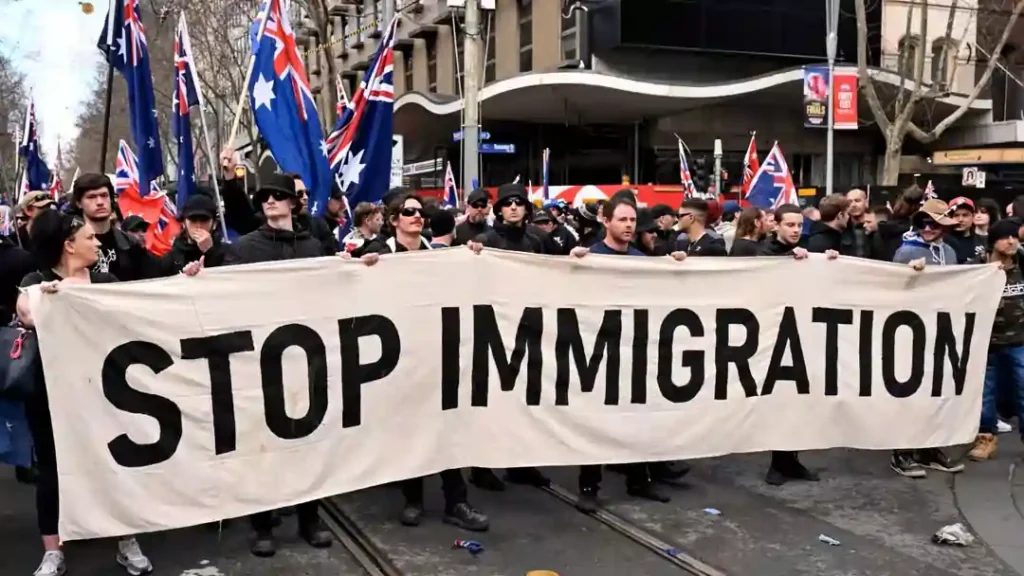New Delhi: Australia was rocked by a series of controversial anti-immigration rallies on August 31, 2025, under the banner “March for Australia,” with protesters singling out the Indian migrant community. Held in major cities including Sydney, Melbourne, Brisbane, Canberra, Adelaide, and Perth, these demonstrations drew thousands demanding an end to what they called “mass migration.” The Australian government, community leaders, and counter-protesters have condemned the rallies as divisive, extremist, and linked to neo-Nazi groups, highlighting a growing wave of anti-immigration sentiment in the Global North.

“March for Australia” Protests: A Nationwide Movement
On Sunday, August 31, 2025, the “March for Australia” rallies saw significant turnout across Australia’s largest cities. In Sydney, the Australian Broadcasting Corporation (ABC) estimated 5,000 to 8,000 attendees, many draped in Australian flags, chanting for an end to immigration. Melbourne witnessed violent clashes between anti-immigration marchers and counter-protesters, prompting police to deploy pepper spray and baton rounds. At least six arrests were made in Melbourne on charges including assault, according to SBS News. Similar rallies in Perth, Canberra, Brisbane, and Adelaide drew hundreds to thousands, amplifying the movement’s reach.
The federal government, led by the Labor Party, issued strong condemnations. Labor Minister Murray Watt labeled the rallies as extremist-driven, stating they were not about social harmony but rather spreading hate and division. Multicultural Affairs Minister Anne Aly went further, declaring the events “organised by Nazis” and specifically targeting non-white immigration. Counter-protests, including one by the Refugee Action Coalition in Sydney, highlighted opposition to the far-right agenda, with a spokesperson noting the “depth of disgust and anger” toward the rallies’ rhetoric.
In Melbourne, the protests took a darker turn when a group of men in black, including neo-Nazi Thomas Sewell, attacked an Indigenous protest camp called Camp Sovereignty. Four people were injured, including a woman hospitalized, with organizers reporting that police arrived only after the attackers had left, making no arrests. The presence of Sewell, founder of the National Socialist Network, underscored the government’s warnings about extremist involvement.
Organizers and Extremist Links
The organizational structure behind “March for Australia” remains murky. No single group has publicly claimed full responsibility, but media investigations have identified key figures. The Sydney Morning Herald reported that a digital creator known as “Bec Freedom” took ownership of the Sydney protest, describing herself as a “freedom fighter,” “nationalist,” and “patriot.” In a leaked audio, she framed the march as protecting “white, Australian heritage,” equating it to safeguarding European and white culture to avoid being labeled a “Nazi rally.” Far-right influencer Hugo Lennon was also identified by ABC as an organizer, known for promoting “remigration”—the mass deportation of non-white immigrants—and the debunked “great replacement” conspiracy theory, which claims white populations are being supplanted by immigrants.
Thomas Sewell, a prominent neo-Nazi, addressed the Melbourne rally from Parliament House steps, further linking the protests to extremist ideologies. The “March for Australia” group called for no foreign flags at events, and some members distanced themselves after Sewell’s involvement. Their website and social media claimed that “mass migration has torn at the bonds that held our communities together,” a stance critics denounced as rooted in racism and ethnocentrism.
Promotional flyers specifically targeted the Indian expat community, alleging that more Indians have migrated to Australia since 2020 than the total Greek and Italian arrivals since 1925. Australian demographer Peter McDonald told SBS News that such comparisons are flawed, as official data collection began years after European immigration waves, and similar rhetoric was used against those groups historically.
Why Anti-Immigration Sentiment is Rising
The protests reflect broader anti-immigration trends in the Global North, driven by several factors:
- Securitization of Migration: Migration is increasingly framed as a threat to national and cultural security, prompting calls for tighter borders. Many fear high immigration erodes their sense of home, a sentiment echoed in campaigns like Brexit.
- Economic Protectionism: Perceptions that immigrants strain resources and accept lower wages, undercutting native workers, fuel economic concerns.
- Nationalism and Deglobalization: Rising nationalism prioritizes domestic interests over migrant welfare, retreating from global interconnectedness.
- Right-Wing Populism: Populist parties exploit anti-immigrant fears, portraying migration as a threat to identity and security through misleading narratives.
- Xenophobia and Cultural Violence: Fear of “otherness” and media-driven dehumanization of migrants reinforce protectionist attitudes.
In Australia, a June 2025 Lowy Institute poll found 53% of Australians believe migrant numbers are “too high,” up five points from 2024. Conservative radio host Ben Fordham claimed in August 2025 that 1,544 migrants—equivalent to five Boeing 787 Dreamliners—arrive daily, projecting a population increase of 1.4 million in three years, akin to Adelaide’s size. Official data shows Net Overseas Migration (NOM) at 446,000 for 2023-2024, down from 536,000 the previous year, but critics note this includes temporary movements like students, not just permanent immigration.
Demographer Liz Allen from the Australian National University attributed the unrest to misinformation about migrants suppressing wages, stealing jobs, or inflating house prices, particularly rents, which have risen since 2020. She linked the sentiment to four domestic crises—housing affordability, climate change, gender inequality, and economic insecurity—combined with a “fear of the other” and anxiety about being “left behind.”
Indian Migrants in Australia: A Growing Presence
Indians are Australia’s second-largest migrant group after the UK. As of June 2023, 845,800 Indian-born residents lived in Australia, more than double the 378,480 a decade earlier, comprising 10.3% of the overseas-born population and 3.2% of the total population. A government report, “An India Economy Strategy to 2035,” noted that from 2006 to 2016, Indian immigration surged due to education-related and skilled migration during the mining boom, addressing labor shortages. The late 2000s saw attacks on Indians, mirroring current concerns.
Indian migrants are nearly three times more likely to hold bachelor’s degrees or higher and possess greater wealth. In 2016, Hindi, Punjabi, and Malayalam were the top Indian languages spoken. Indian community leaders urged migrants to stay indoors during the rallies for safety, with some workers fearing targeted violence. A large police presence was deployed, coinciding with other events like pro-Palestine rallies.
Immigration Trends and Misinformation
Australia’s NOM rose from 187,000 in June 2014 to over 445,000 in June 2024. Between 2016 and 2020, it hovered at 206,000-263,000 annually, dipping negative in 2021 due to COVID-19 border closures (95,000 more departures than arrivals in March 2021). Post-restrictions, it surged to 342,000 by September 2022 and 433,000 by December 2022. Protesters cited Overseas Arrivals and Departures data, but the Australian Bureau of Statistics clarified it reflects traveler intentions, not residency changes, and is unsuitable for measuring migration.
Extremism and Legislative Response
Australia has seen a rise in right-wing extremism. In 2020, the Australian Security Intelligence Organisation (ASIO) flagged neo-Nazis as a “real threat.” Director General Mike Burgess warned of higher foreign espionage risks than during the Cold War, including a “sleeper agent.” In February 2025, parliament passed laws mandating one to six-year jail terms for hate symbols and terror offenses, following attacks on Jewish targets like synagogue fires in Sydney and Melbourne, linked to the Israel-Gaza conflict since October 2023. A 2019 Christchurch mosque attack by an Australian-born white supremacist, killing 51 Muslims, remains a grim precedent.
Indian Diaspora’s Significance and Support
The Indian diaspora is crucial for India, receiving USD 118.7 billion in remittances in 2023-24, the highest globally. It aids diplomacy, such as the Indo-US civil nuclear deal, and promotes soft power through Indian culture—music, dance, festivals, cuisine, films, and yoga. Initiatives like the Indian Community Welfare Fund (ICWF) assist distressed Overseas Indians, while the Pravasi Bharatiya Bima Yojana (PBBY), launched in 2017, offers Rs. 10 Lakhs insurance for accidental death.
Government and Community Response
The Labor government reiterated, “There is no place for any type of hate in Australia.” Greens deputy leader Senator Mehreen Faruqi called the rallies “acts of racist fear mongering and hate,” urging an end to “racist dog-whistling” and implementation of the National Anti-Racism Framework. Protester Glenn Allchin voiced concerns about infrastructure strain: “Our country bursting at the seams… our kids struggling to get homes, our hospitals – we have to wait seven hours – our roads, the lack of roads.”
Counter-protesters emphasized Australia’s immigrant roots, noting that outside Indigenous people, most are immigrants or descendants. The rallies highlight tensions in a nation where one in two people is born overseas or has an overseas-born parent, underscoring the challenge of balancing multiculturalism with rising anti-immigration views.
Conclusion
The 2025 “March for Australia” protests, targeting Indian migrants, reflect a complex interplay of economic fears, cultural anxieties, and extremist ideologies. As Australia navigates these challenges, addressing misinformation, fostering inclusive policies, and countering far-right extremism will be critical to maintaining its multicultural identity.
Frequently Asked Questions
1. What were the “March for Australia” rallies in 2025?
The “March for Australia” rallies were a series of anti-immigration protests held on August 31, 2025, across major Australian cities including Sydney, Melbourne, Brisbane, Canberra, Adelaide, and Perth. Organized to demand an end to “mass migration,” the rallies specifically targeted the Indian migrant community, drawing thousands of participants, some draped in Australian flags. The events saw clashes with counter-protesters, police intervention, and condemnation from the Australian government for promoting hate and extremism.
2. Why were Indian migrants singled out in these protests?
Promotional flyers for the rallies claimed that Indian immigration since 2020 has outpaced historical Greek and Italian arrivals, alleging it strained community bonds. As Australia’s second-largest migrant group after the UK, with 845,800 Indian-born residents as of June 2023, Indians were targeted amid broader anti-immigration sentiment. Demographer Peter McDonald noted such comparisons are flawed due to incomplete historical data, but the rhetoric reflects rising xenophobia and fears of cultural change.
3. Who organized the “March for Australia” rallies?
No single group officially claimed responsibility, but media identified figures like “Bec Freedom,” a self-described nationalist, and far-right influencer Hugo Lennon, who promotes “remigration” and the “great replacement” conspiracy. Neo-Nazi Thomas Sewell, founder of the National Socialist Network, addressed the Melbourne rally, linking the events to extremist ideologies. The government and critics denounced the rallies as rooted in racism and ethnocentrism.
4. How did the Australian government and community respond?
The Labor government condemned the rallies as divisive and extremist, with Minister Anne Aly labeling them as “organised by Nazis.” A large police presence was deployed, using pepper spray and baton rounds in Melbourne to manage clashes. Indian community leaders urged migrants to stay indoors for safety, while counter-protests, like those by the Refugee Action Coalition, opposed the far-right agenda. Greens Senator Mehreen Faruqi called for an end to “racist dog-whistling” and stronger anti-racism measures.
5. What broader issues fueled the anti-immigration sentiment?
The rallies reflect global trends in the Global North, including securitization of migration, economic protectionism, nationalism, right-wing populism, and xenophobia. In Australia, a June 2025 Lowy Institute poll showed 53% of Australians felt migration levels were “too high.” Misinformation about migrants impacting wages, jobs, and housing, coupled with domestic crises like housing affordability and economic insecurity, fueled fears of being “left behind,” as noted by demographer Liz Allen.

